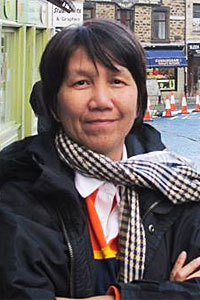
The heavy floods that have ravaged Ubon Ratchathani and other northeastern provinces are a wake-up call for authorities dealing with natural disasters.
According to Seree Suparatid, an expert on climate change and disasters at Rangsit University, the massive floods were caused when rain from two major storms overwhelmed the capacity of the Northeast's major Chee and Moon rivers, which converge in Ubon Ratchathani before draining into the Mekong. The expert also blamed unplanned development and rapid urbanisation for the disaster.
Mr Seree encouraged other provinces to remain on alert for more flooding as Thailand experiences extreme weather patterns.
The magnitude of the floods that hit Ubon Ratchathani caught authorities off guard. What has followed are poorly prepared relief operations coupled with panicked responses which have shamefully aggravated the plight of victims. The sight of villagers and their pets marooned on house roofs, waiting for state assistance and relief as the water submerged upper floors, triggered an outpouring of public anger.
State authorities are stuck in the conventional assistance pattern: distributing relief bags, food supplies and evacuating victims to relief centres. Proactive planning and efficiency are not in the bureaucrats' vocabulary. How many floods and disasters have they tackled? It astounds me to see them still performing so ineptly, dealing so clumsily with urgent problems.
Prime Minister Prayut Chan-o-cha, who on Thursday inspected the disaster zone in Ubon Ratchathani's Warin Chamrap district, conceded that red tape has significantly hindered relief operations conducted by state agencies. During the visit, which was his second to the northeastern province in less than two weeks, he promised to speed up disbursement of relief funds to ensure assistance reaches people sooner. The flooding is forecast to last until the end of the month as water levels slowly recede.
Before visiting the worst-hit area, the prime minister led celebrities in a televised fundraising event which garnered some 300 million baht.
While bureaucrats felt the sting of public criticism, actor-turned-rescue-worker Bin Banluerit stole the show, handing out relief supplies and cash he had collected from kindhearted donors to beleaguered villagers, well before state rescue officials arrived on the scene. His brave act has deeply moved society and inspired other good Samaritans to launch the #saveubol campaign.
A civic group with disaster-relief experience from the 2004 tsunami, which killed thousands along the Andaman coast, visited embattled villagers in Warin Chamrap -- the epicentre of the flood disaster.
The Phangnga-based Ban Nam Khem group, led by prominent activist Maitree Jongkraijug, came bearing emergency food supplies, including fish they had brought from their own communities. They also arrived with the group's Ban Nam Khem disaster management model, which prioritises victims' participation, and quickly began examining the community's needs.
Mr Maitree said he was dumbfounded to see how state agencies were in disarray. A double disaster had resulted from their underestimation of the devastating power of the two storms.
The southern civic group liaised with networks in Ubon Ratchathani and came up with the idea that, to prepare for worsening disasters in the wake of climate change, local villagers must be equipped with knowledge and tools to create self-reliance, instead of waiting for state help. Joining hands with the Nong Kin Plane Tambon Organisation Administration, they have launched a project to build boats to allow the evacuation of flood-hit villages. After an appeal for public donations, they aim to build 10 boats at a cost of 60,000 baht each. Donations are already flowing in, and the first boat is under construction, supported by the state disaster prevention department.
Hopefully the boat project and Ban Nam Khem model can inspire other communities to think deeply about disaster prevention and mitigation, instead of focusing exclusively on economic expansion and building infrastructure such as roads that, without proper planning, can block water flow and worsen floods.
The boat-making project and other disaster-mitigation efforts are a small but significant step with a noble goal of making vulnerable communities more self-reliant and able to cope with natural disasters. Calls are growing for the disaster prevention law to be amended to enhance the role of local communities in preparation and relief works. Now the ball is in the politicians' court. How long will it take them to realise that vulnerable local communities themselves should be given the power to tackle impacts of natural disasters?
Nauvarat Suksamran is an assistant news editor, Bangkok Post.
